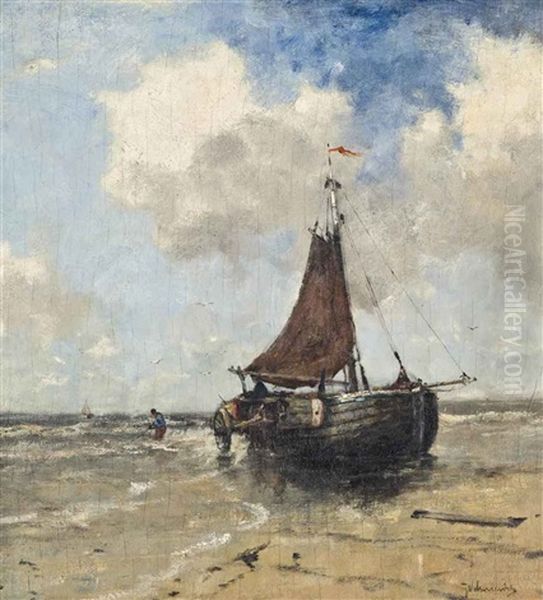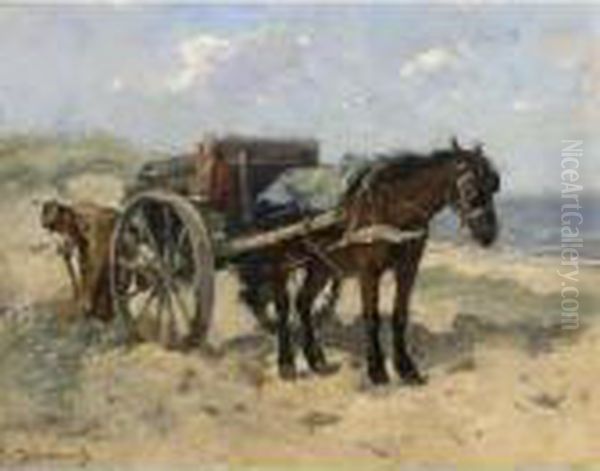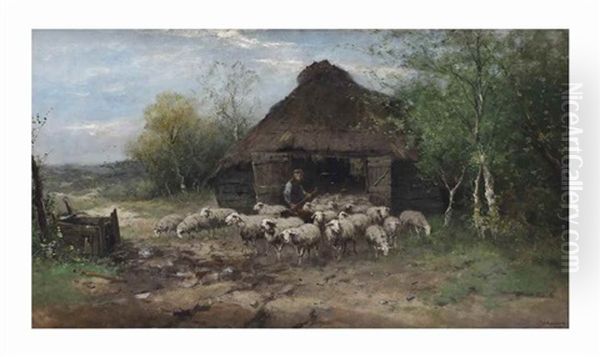Johan Frederik Cornelis Scherrewitz stands as a notable figure in Dutch art history, particularly recognized for his evocative depictions of the Netherlands' landscapes, coastal scenes, and the lives of its rural inhabitants. Born in Amsterdam on March 18, 1868, and passing away in Hilversum in 1951, Scherrewitz's life spanned a period of significant artistic transition. He became a respected painter, capturing the enduring spirit of Dutch life with a style influenced by the renowned Hague School, yet possessing its own distinct character.
Early Life and Artistic Inclination
Born into a family in Amsterdam, the bustling heart of the Netherlands, Scherrewitz's path initially seemed destined for the world of finance. His family harbored ambitions for him to become a stockbroker, a profession far removed from the canvases and easels that would later define his life. However, the young Scherrewitz felt a stronger pull towards the arts. Resisting familial expectations, he chose to follow his passion for painting, a decision that would shape his entire future.
This early determination set the stage for his artistic journey. He sought formal training to hone his nascent skills, initially taking drawing and painting lessons in Velsen. This foundational education was crucial, providing him with the technical grounding necessary to translate his observations of the world onto canvas. His commitment to art over commerce marked him as an individual dedicated to his craft from a young age.
Training and Formative Influences
Scherrewitz's formal artistic development significantly advanced under the tutelage of respected painters. He studied with Johan Diderik Cornelis Veltens, gaining valuable insights and techniques. Perhaps more significantly, he became a pupil of George Jan Hendrik Poggenbeek (1853-1903). Poggenbeek was an established artist associated with the Hague School and Dutch Impressionism, known for his atmospheric landscapes, particularly scenes featuring water and cattle.

Poggenbeek's influence on Scherrewitz is often noted, particularly in guiding his pupil towards excelling in capturing the nuances of Dutch rural and agricultural life. The Hague School's emphasis on realism, atmospheric effects, and the depiction of everyday life resonated deeply with Scherrewitz. This movement, flourishing in the latter half of the 19th century, sought to portray the Netherlands authentically, moving away from the idealized scenes of Romanticism.
Key figures of the Hague School, such as Anton Mauve (1838-1888), famous for his sheep flocks in misty landscapes, Jozef Israëls (1824-1911), known for his poignant portrayals of fishermen's lives, and Hendrik Willem Mesdag (1831-1915), celebrated for his dynamic seascapes, created a rich artistic environment. Others like Jacob Maris (1837-1899) and his brother Willem Maris (1844-1910), along with Johannes Bosboom (1817-1891) known for church interiors, defined the school's diverse yet cohesive focus on Dutch light and landscape. Scherrewitz absorbed these influences, integrating their tonal palettes and thematic concerns into his own developing style.
Development of Style and Subject Matter
Scherrewitz carved a niche for himself by focusing intently on specific aspects of Dutch life and landscape. His oeuvre is dominated by scenes of the countryside, coastal areas, and the people who worked the land and sea. He was particularly drawn to the forests near Oosterbeek and the heathlands around Laren and Hilversum, areas known for their natural beauty and association with artists. The coastal regions, especially Katwijk, provided inspiration for his depictions of fishermen and their sturdy vessels.
His style is often characterized as being aligned with the later phase of the Hague School or a continuation of its principles into the early 20th century. He employed a realistic approach, yet imbued his works with a strong sense of atmosphere, often capturing the characteristic silvery or grey light of the Dutch climate. His brushwork, while detailed, could also exhibit a certain looseness, hinting at Impressionistic sensibilities without fully embracing the dissolution of form seen in French Impressionism or even the bolder style of Amsterdam Impressionists like George Hendrik Breitner (1857-1923) or Isaac Israëls (1865-1934).
Scherrewitz primarily worked in oil paint, the medium allowing him to build up textures and capture the interplay of light and shadow effectively. His signature, often rendered simply as "J Scherrewitz," became a mark of quality on works depicting the quintessential Dutch experience – the farmer with his horses, the shepherd with his flock, or the fisherman battling the elements.
Key Themes: Fishermen and the Coast

A recurring and powerful theme in Scherrewitz's work is the life of the Dutch fisherman. He frequently painted scenes along the North Sea coast, particularly depicting the distinctive flat-bottomed fishing boats known as 'bomschuiten'. These vessels were essential to coastal communities like Katwijk and Scheveningen, used for fishing and often hauled onto the beach by horses.
Scherrewitz captured various aspects of this life: boats setting sail, returning with the day's catch, or being unloaded on the shore. He often depicted these scenes under the vast, often overcast, skies typical of the region, emphasizing the fishermen's resilience and their intimate connection with the sea. These works echo the thematic concerns of Hague School masters like Jozef Israëls and Hendrik Willem Mesdag, but Scherrewitz brought his own sensitivity to the subject, focusing on the daily rhythms and labour involved. His paintings convey the atmosphere of the coast – the damp air, the smell of salt and fish, the sturdy figures of the fishermen and their families.
Key Themes: Shepherds and Pastoral Life
Alongside the coastal scenes, Scherrewitz was equally adept at portraying the pastoral life of the Dutch interior. He frequently painted shepherds guiding their flocks across heathlands or near simple sheepfolds ('schapenkotten'). These works often evoke a sense of tranquility and timelessness, depicting a way of life deeply connected to the land.
His depictions of sheep and shepherds connect him clearly to Anton Mauve, perhaps the most famous painter of this subject within the Hague School. Like Mauve, Scherrewitz captured the textures of the sheep's wool and the specific quality of light on the heath. However, Scherrewitz's scenes often possess a quiet dignity, focusing on the harmonious relationship between the shepherd, his animals, and the landscape. These pastoral images offered a counterpoint to the more rugged coastal scenes, showcasing the diversity of rural Dutch life.
Other agricultural scenes, such as farmers working with horses, ploughing fields, or carting materials, also feature in his work. These paintings underscore his commitment to documenting the traditional labour and landscapes of his homeland before the full onset of 20th-century modernization.
Representative Works
Several specific titles stand out as representative of Scherrewitz's thematic interests and artistic skill:

"Bomschuit en schenkelkar op het strand van Katwijk" (often translated as "Bomb Ketch and Cart on Katwijk Beach" or similar): This title clearly indicates a scene central to his coastal repertoire – the iconic fishing boat and associated cart used for transport on the beach, likely depicted with figures involved in unloading or preparing for sea. Such a work would showcase his ability to render the boat's structure, the sandy terrain, and the atmospheric coastal light.
"A shepherd and his flock near sheepfolds": This title points directly to his pastoral themes. One can envision a composition featuring a solitary shepherd, perhaps with his dog, overseeing a multitude of sheep grazing on the heath, with the simple structure of a sheepfold providing context. It would highlight his skill in painting animals and the expansive, subtly coloured landscapes of the Gooi region where he lived and worked.
"Landing the day's catch": Similar to the Katwijk beach scene, this title emphasizes the moment of return and the culmination of the fishermen's labour. It likely depicts boats arriving, nets being handled, and the catch being brought ashore, possibly involving multiple figures and conveying the activity and perhaps hardship of this profession.
"Carting Sand": This subject suggests a scene of labour within the landscape, perhaps related to dune management or construction. It would involve horses, a cart, and figures engaged in physical work, allowing Scherrewitz to explore themes of human interaction with the environment.
These titles, representing both his coastal and inland subjects, encapsulate the core of Scherrewitz's artistic output. While specific images for each title vary, they consistently point to his focus on authentic Dutch scenes rendered with atmospheric sensitivity.
Career Trajectory and Geographic Focus
Scherrewitz's career unfolded across several key locations in the Netherlands, each likely contributing to his artistic development and subject matter. He began his professional life in Amsterdam, where he lived and worked until approximately 1898. The city, while a hub of artistic activity, perhaps served more as a base during his formative years.
His subsequent move to Laren marked a significant shift. Laren, in the Gooi region, was an established artists' colony, attracting painters drawn to its picturesque heathlands, forests, and rural charm. Figures associated with the Hague School, like Anton Mauve, had worked there, popularizing its landscapes. Scherrewitz's time in Laren undoubtedly immersed him in the pastoral subjects that became central to his work.
After Laren, he spent a couple of years in Haarlem (circa 1902-1904). Located closer to the coast and the Kennemer dunes, Haarlem may have provided fresh inspiration for coastal and dune landscapes. Finally, he settled in Hilversum, also in the Gooi region, where he remained for the rest of his life. This area, similar to Laren, offered continued access to the heathlands, woods, and pastoral scenes he favoured. His geographic movements reflect a deliberate engagement with the landscapes he chose to paint.
Exhibitions, Recognition, and Market Presence
Johan Frederik Cornelis Scherrewitz achieved considerable recognition during his lifetime. He actively participated in the art world, exhibiting his works regularly. Records show his participation in exhibitions held in major Dutch cities like The Hague and Amsterdam between 1895 and 1903, placing his work before the public and critics.
His reputation extended beyond the Netherlands. His paintings found favour with audiences and collectors in Great Britain and the United States, indicating an international appeal for his quintessential Dutch scenes. He exhibited works at prestigious venues, including the Royal Academy in London, a significant achievement for a foreign artist. This international exposure contributed to his standing and the dissemination of his work.
Furthermore, Scherrewitz gained recognition within the Dutch art establishment. He was elected to membership in important artists' societies, such as the Amsterdam-based "Arti et Amicitiae" (Art and Friendship) and likely the "Pulchri Studio" in The Hague, although sources sometimes generically mention "St. Luke's Academy" or "Amsterdam Art Association". Membership in these societies provided opportunities for exhibition and interaction with fellow artists.
His work continues to be appreciated today. Paintings by Scherrewitz are held in the collections of several Dutch museums, including the prestigious Rijksmuseum in Amsterdam and the Museum Flehite in Amersfoort (near Ede). His works also appear regularly on the art market, fetching respectable prices at auction. For instance, a painting titled "Hearding the flock" was noted at a Munich auction in 2005, and another work, possibly "Wooden cart," sold for £4,375 at Bonhams Knightsbridge in London in 2012. This ongoing market presence demonstrates a sustained interest in his art among collectors.
Scherrewitz in the Context of the Hague School and Contemporaries
Placing Scherrewitz within the broader context of Dutch art, he is firmly situated within the tradition of the Hague School. While the first generation laid the groundwork in the 1860s and 1870s, Scherrewitz belongs to a later period, carrying the school's ideals of realism, atmospheric depiction, and focus on Dutch life into the early 20th century. His work embodies the school's preference for tonal harmony over bright colours, often employing a palette rich in greys, browns, and muted greens to capture the specific light and mood of the Netherlands.
While influenced by Poggenbeek, his work resonates with themes explored by many Hague School artists. His fishermen recall Jozef Israëls, his sheep echo Anton Mauve, his landscapes share sensibilities with Jan Hendrik Weissenbruch (1824-1903), and his coastal scenes relate to Mesdag. However, Scherrewitz developed his own recognizable style, perhaps less dramatic than Mesdag's seas or less overtly sentimental than some of Israëls' peasant scenes, often achieving a quiet, observational dignity.
Interestingly, despite working within this well-established tradition and milieu, specific records detailing his direct interactions or collaborations with many other prominent contemporaries are scarce. While he was a member of artists' societies, suggesting collegial contact, documented friendships or joint artistic ventures with figures like Floris Arntzenius (1864-1925), known for his Hague cityscapes, or Bernard Blommers (1845-1914), another painter of fisherfolk and genre scenes, are not widely cited in available sources. His primary documented connection remains with his teachers, Veltens and Poggenbeek. This lack of documented interaction doesn't diminish his place but suggests he may have pursued his artistic path with a degree of independence within the broader movement.
Later Life and Legacy
Johan Frederik Cornelis Scherrewitz continued to paint into his later years, remaining based in Hilversum. He passed away in 1951 at the age of 83, leaving behind a substantial body of work dedicated to the landscapes and people of his native country. His long career allowed him to witness significant changes in the art world, yet he largely remained faithful to the realistic and atmospheric style rooted in the Hague School tradition.
His legacy lies in his contribution to the visual record of Dutch life during a period of transition. He captured enduring aspects of rural and coastal existence – the labour of fishermen, the quiet watchfulness of shepherds, the play of light on water and land – with sincerity and skill. While perhaps not considered an innovator on the scale of the pioneers of the Hague School or the subsequent avant-garde movements, Scherrewitz was a highly competent and successful artist who found a receptive audience both at home and abroad.
His paintings continue to be valued for their evocative portrayal of the Netherlands, offering a window onto the past. The presence of his work in museum collections and its continued circulation on the art market attest to his lasting appeal as a painter who skillfully and affectionately documented the soul of the Dutch landscape and its traditional ways of life.
Art Historical Assessment
In art historical terms, Johan Frederik Cornelis Scherrewitz is assessed as a significant representative of the later Hague School tradition. He successfully absorbed the lessons of his predecessors and contemporaries, particularly the emphasis on atmospheric realism and the choice of typically Dutch subject matter. His work is characterized by its technical proficiency, its sensitivity to light and mood, and its consistent focus on themes of rural labour and landscape.
He is respected for his skillful depictions of fishermen, shepherds, horses, and coastal environments. While he operated within an established stylistic framework, he did so with a distinct voice, creating works that are both representative of the broader movement and recognizable as his own. His popularity in Britain and America during his lifetime speaks to the universal appeal of his chosen subjects and his manner of portraying them.
While not typically ranked alongside the absolute masters of Dutch art history like Rembrandt or Vermeer, or even the leading innovators of the Hague School like Mauve or Maris, Scherrewitz holds a secure place as a talented and productive painter who made a valuable contribution to the rich tapestry of Dutch landscape and genre painting. His work remains a testament to the enduring beauty he found in the everyday scenes of his homeland.
Conclusion
Johan Frederik Cornelis Scherrewitz dedicated his artistic life to capturing the essence of the Netherlands. From the windswept beaches of Katwijk to the quiet heathlands of the Gooi, his canvases reflect a deep connection to the land and its people. Influenced by the Hague School yet developing his own nuanced style, he portrayed fishermen, shepherds, and farmers with empathy and realism. His ability to render the unique atmosphere and light of the Dutch landscape secured him recognition during his lifetime and ensures his work continues to be appreciated today. As a chronicler of a disappearing way of life and a painter of evocative, atmospheric scenes, Scherrewitz remains an important figure in the story of Dutch art.